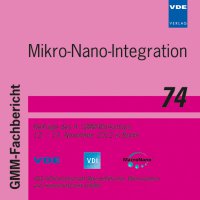Enhancement of Humidity Barrier Properties of Polymers with Micro- and Nano-sized Filler Particles
Conference: Mikro-Nano-Integration - 4. GMM-Workshop
11/12/2012 - 11/13/2012 at Berlin, Deutschland
Proceedings: Mikro-Nano-Integration
Pages: 6Language: englishTyp: PDF
Personal VDE Members are entitled to a 10% discount on this title
Authors:
Braun, T.; Bauer, J.; Georgi, L.; Becker, K.-F.; Koch, M.; Aschenbrenner, R. (Fraunhofer Institute for Reliability and Microintegration, Gustav-Meyer-Allee 25, 13355 Berlin, Germany)
Lang, K.-D. (Technical University Berlin, Microperipheric Center, Germany)
Abstract:
Polymer materials - mainly epoxy resins - are widely used in microelectronics packaging. They are established in microsystem manufacturing, for adhesives as die attach glues or for encapsulants as molding compounds, glob tops or underfill materials. Low cost and mass production capabilities are the main advantages of these materials. But like all polymers they cannot provide a hermetical sealing due to their permeability properties. The susceptibility to diffusion of liquids and gases through the polymer and along the interfaces is a drawback for polymer materials in general, as water or other media inside a microelectronic package might lead to softening of the material and to a decreasing adhesive strength and resulting delaminations close to solder bumps or wire bonds reducing package reliability by decreasing the package structural integrity. Therefore, plastic packaging materials with enhanced humidity resistance allowing the manufacturing of miniaturized microsystems for demanding applications as e.g. medical devices would increase package reliability during assembly and lifetime ideally without cost increase and with no changes in processing. As filler particles have an important influence on the final material properties of microelectronic encapsulants, they are well suited for material modifications. Typically micro-sized silica particles are incorporated into the polymer matrix as the thermo-mechanical properties could be well adapted to reliable packaging demands. However, there are a lot of nano- and micro-sized filler particles with potential to enhance the humidity barrier properties of encapsulants. Working principles of these particles may range from large surface impact of nano-particles, barrier functionality due to stacked layer formation (nano-clays), highly hydrophobic particle surface and molecular water catcher function. Micro- and nano-sized SiO2, bentonite, zeolites, Al2O3, carbon black and carbon nano tubes have been selected for a systematic study. To evaluate the potential of such additives concerning moisture resistance particles are mixed with a microelectronic grade epoxy resin. Neat particles as well as formulations are characterized regarding their water absorption, diffusion and barrier properties. Additionally multi-layer encapsulants with highest humidity barrier properties are introduced. Here, the mechanical or thermo-mechanical functionality is separated from humidity barrier characteristic. Polymer layers are processed wet in wet resulting in a homogeneous encapsulation with gradient material properties. Different methods for characterization of the diffusion properties close to microelectronics application have been developed and applied for material analysis. The pros and cons of simple weight measuring for absorption testing, sorption analysis, TGA desorption measuring, dielectric spectroscopy and encapsulated humidity sensors are presented and discussed along testing results with formulations with the different filler particles. The results of the measurement allow a modeling of the diffusion behavior of the characterized encapsulants and therewith a forecast on the later reliability of the overall system.


